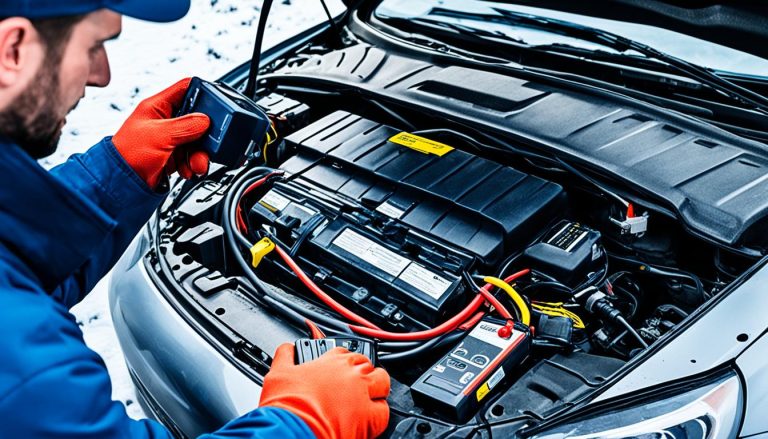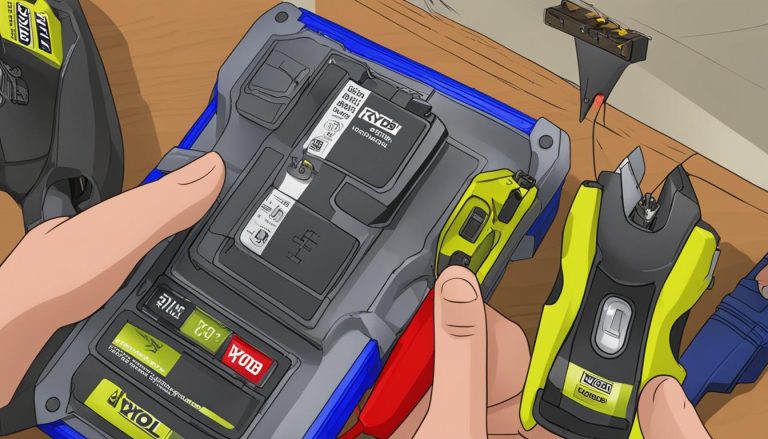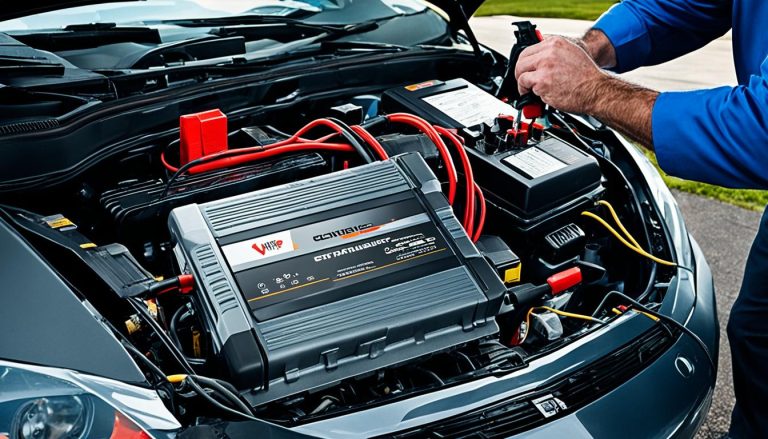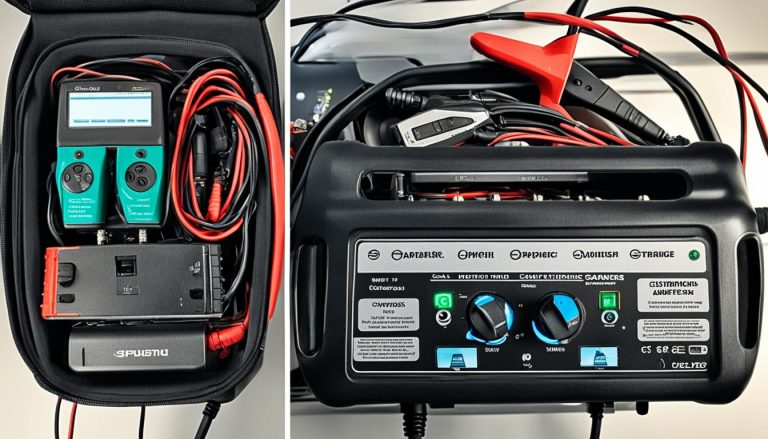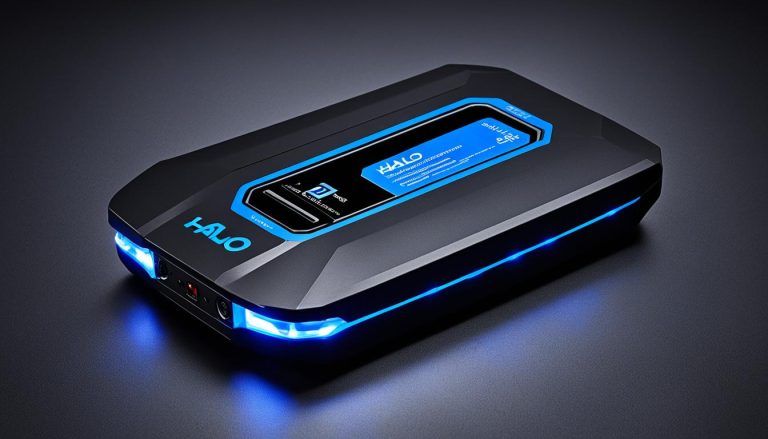Charging a Battery with a Jump Starter FAQ
batterychargers.site and its partners may earn a commission if you purchase a product through one of our links
Have you ever found yourself puzzled over the question, “Can you use a jump starter to charge a battery?” If your car refuses to start, you might consider reaching for a jump starter as a quick solution. You are not alone in thinking that a jump starter might serve as a makeshift charger. Yet, it’s important to grasp that charging a battery with a jump starter is not the same as using a dedicated charger, as it simply provides the burst of energy needed to get your engine running.
The process of how to charge a battery with a jump starter is often misunderstood. Although a jump starter is a handy tool to have in your trunk, especially in emergencies, it lacks the capacity to fully charge a battery directly. Think of jump starters as a short-term solution to a flat battery situation, giving you enough juice to start the engine where the alternator will then take over the charging responsibilities.
Key Takeaways
- A jump starter can provide a quick power burst to start your car, not charge your battery.
- Jump starters and dedicated chargers operate differently; understanding this helps prolong device life.
- For a full charge, rely on your alternator after starting the vehicle or use a mains-connected charger.
- Remember, the safety and convenience of using a portable jump starter can save you both time and hassle.
- Proper connection and use of a jump starter are crucial for efficient operation and to avoid damage.
Understanding the Functionality of Jump Starters
When you’re in a pinch, a jump starter for battery charging stands out as your reliable companion, ready to breathe life into your vehicle’s engine with a push of a button. But how exactly does this compact device manage such a feat? It’s a harmony of power and precision engineered to provide that needed jolt to your car’s heart.
How Jump Starters Work to Power Your Vehicle
At its core, the jump starter is home to a battery array that houses a significant amount of energy. Unlike traditional chargers that offer a gentle and steady stream of power, a jump starter unleashes energy in short, potent bursts. These bursts are high in amperage, capable of jolting the engine’s electrical system, prompting it to awaken and roar to life. Particularly useful in emergency scenarios— whether it’s due to a sudden battery demise or the parasitic drain from not driving for a while—these devices safeguard against the inconveniences of engine silence.
The Role of a Jump Starter’s Battery Array
The sophistication of the jump pack battery replacement technology is evident when dissecting the capabilities of the battery array. This powerhouse component is what sets these devices apart, especially when looking for a high power jump starter or one fit for the daunting task of firing up a heavy duty jump starter for semi truck. These varieties cater to varying power needs, underlining the adaptability of jump starters and why they’re a must-have tool in your vehicular emergency kit.
- Compact Design: Jump starters are remarkable for their portability, allowing ease of storage and transport.
- Rapid Response: Designed for immediate action, they provide quick power delivery when every second counts.
- Versatility: Models are available for different vehicle types, from standard cars to heavy-duty trucks.
In essence, the jump starter is a marriage of convenience and necessity — it’s there when you need it, without the fuss of a prolonged setup, and robust enough to handle the demands of various vehicle types. It’s not just an accessory, but a safeguard against the unpredictable nature of battery life.
Can I Charge a Battery with a Jump Starter?
If you’ve ever faced the inconvenience of a dead battery, you know the critical role a jump starter plays. Common questions like “Can a jump starter charge a dead battery?” reveal a common confusion among vehicle owners. While a jump starter is instrumental in getting your vehicle running again, it serves a different purpose than a battery charger. The primary intention behind a jump starter is to supply a sudden burst of energy to crank up the engine, not to recharge the battery itself.
Can jump starter charge dead battery for later use, however? It’s a nuanced answer. Jump starters are not equipped to replace the comprehensive charging process delivered by battery chargers, which are specifically designed to restore a depleted battery’s charge over time. Despite this, the power provided by a jump starter can enable the alternator to begin charging the battery once the engine is up and running.

So, if you find yourself with a flat battery and a jump starter in hand, knowing that your charge dead battery with jump starter attempt will not fully replenish the battery’s power may influence your next steps. After jump-starting, it is vital to drive the vehicle to allow the alternator to perform its task of slowly recharging the battery or to employ the services of a dedicated battery charger.
- Recognize the immediate power capabilities of jump starters to start engines.
- Understand that jump starters cannot maintain the output required to fully charge batteries.
- Identify the role of alternators or dedicated chargers in battery charging post jump-start.
In the scenario of being stranded with a non-responsive car, a jump starter is your go-to emergency tool, capable of getting you back on the road. Yet, to ensure your battery is properly and fully charged after the fact, leveraging the continuous power of a battery charger is your best bet.
Comparing Jump Starters and Battery Chargers
When dealing with a dead car battery, you often have two go-to solutions: portable jump starters or battery chargers. Understanding the distinct functions and appropriate scenarios for each can save you from roadside headaches.
Portable Jump Starters vs. Mains-Connected Battery Chargers
Portable jump starters are like mobile power banks for your vehicle’s battery. They are compact, convenient, and can be a lifesaver in locations where access to power is limited. Battery chargers, on the other hand, are more of a long-term solution—they require a power outlet but offer continuous and regulated charging for your car battery.
| Feature | Portable Jump Starter | Battery Charger |
|---|---|---|
| Power Source | Internal battery | Mains electricity |
| Charging Time | Quick burst of energy | Steady, prolonged charge |
| Mobility | High (no power outlet needed) | Low (requires power outlet) |
| Function | Emergency start | Full recharge and maintenance |
| Overcharging Protection | Limited to none | Usually included |
| Usage Scenarios | Unexpected battery failure | Routine maintenance, storage |
Given these differences, it’s clear that while using a jump starter to charge a battery may offer an immediate solution, it’s not designed for charging a car battery. Conversely, a mains-connected battery charger provides a safe, steady supply of energy, making charging car battery with jump starter an option reserved for emergencies.
Why Battery Chargers are Suitable for Long-Term Charging
Battery chargers excel in keeping your car battery at optimal power levels over extended periods. This is especially beneficial for vehicles that are not in regular use to prevent the dreaded flat battery. They’re designed to deliver a trickle charge that keeps the battery topped off without the risk of overcharging, thanks to their built-in safety features.
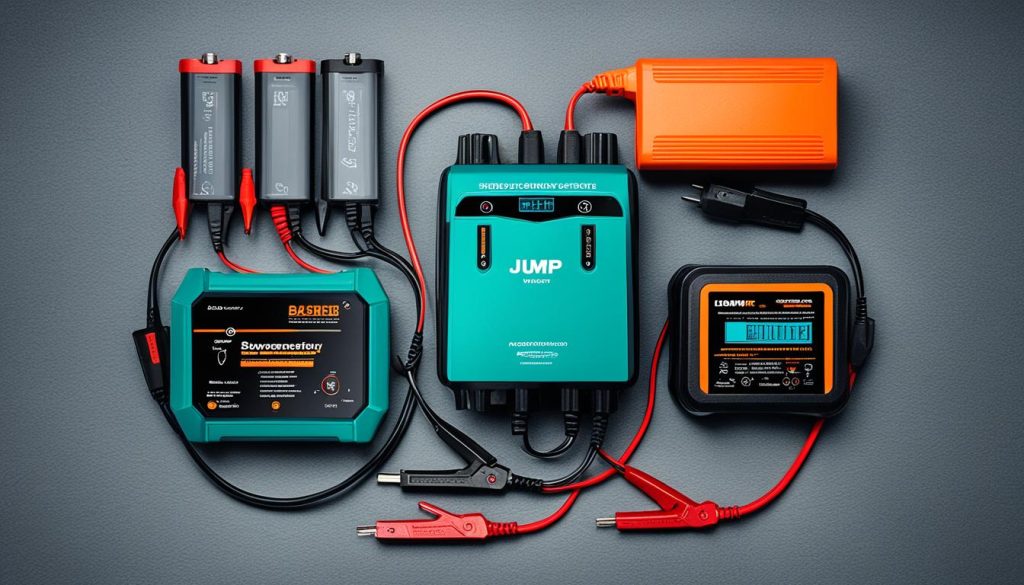
Whether your choice is a quick jump start to get moving or a thorough charge to maintain battery health, understanding the capabilities of battery charging with jump starter versus traditional chargers is critical. Remember to always follow the manufacturer’s guidelines for the safe and effective use of these devices.
The Convenience and Safety of Using Jump Starters
When your battery fails, the age-old solution of jumper cables and a second vehicle is no longer your only option. Portable car jump starters, commonly referred to as jump boxes, have revolutionized this roadside dilemma, providing a self-contained power unit that can get your car running without the need for another car. With autonomy and safety as prime benefits, these devices are swiftly becoming essential backup accessories for drivers everywhere.

Advantages of Jump Packs Over Traditional Jumper Cables
Jump starter for battery charging is a tech-forward choice that offers numerous advantages over traditional jumper cables. With one hooked up in your trunk, you’re ready to handle sudden battery issues securely and efficiently. Here’s a brief overview:
- No need for a donor vehicle – Jump start your car wherever you are, even in isolated parking lots or your own garage.
- Easy to use – Even newcomers find it straightforward with clear instructions and simple operating steps.
- Compact design – Unlike bulky jumper cables, a jump box can fit neatly into most vehicle storage areas.
- Multipurpose use – Come nightfall or an emergency, many jump starters offer additional features like flashlights and SOS signals.
Built-in Safety Features of Modern Portable Jump Starters
The safety component can’t be overlooked when discussing the jump starter safety provided by modern units. Manufacturers are dedicated to making these devices as foolproof as possible, integrating features that not only guide you through the process but ensure your vehicle’s electrical system is shielded from potential damage.
| Feature | Benefit |
|---|---|
| Reverse Polarity Alarm | Alerts you if connections are made incorrectly, protecting your vehicle’s electrical system. |
| Voltage Regulation | Keeps output stable to avoid electrical spikes that can cause damage. |
| Short Circuit Protection | Minimizes the risk of sparks which can lead to battery damage or fire. |
| Battery Status Indicators | Provides a clear understanding of your jump starter’s charge level so it’s ready when you need it. |
Though compact, portable car jump starters are designed to be powerhouses of security and convenience. They’re not just about getting you back on the road—they’re about getting you there safely. With built-in protections and dual-purpose functionalities, these jump boxes are more than mere emergency tools; they’re your reliable companion no matter where your journey takes you.
How to Properly Connect a Jump Starter to Your Battery
If you’ve found yourself with a vehicle that won’t start, knowing how to charge a battery with a jump starter could restore your mobility swiftly and efficiently. First, ensure that your jump starter’s battery is fully charged; this is not just for the immediate need but also beneficial for the jump starter’s longevity. With your jump starter ready, begin by taking the red cable and attaching it securely to the battery’s positive post. Next, connect the black cable to the negative post, forming the necessary circuit to transfer energy from the jump pack to your vehicle’s battery.
With both cables correctly connected, it’s time to initiate the jump starter, which may involve turning on a power switch. This should be done only after you have made sure that the connections are safe and secure. Now, from the comfort of the driver’s seat, attempt to start your engine. Should the engine turn over and roar to life, your task was a success! With the engine running, switch off the jump starter if it has a power button, and carefully disconnect the clamps, starting with the black cable, followed by the red to prevent any sparks or short circuits. It’s crucial to observe safety and ensure proper handling at all times.
Monitoring your jump starter’s charging status is straightforward—many modern units are equipped with indicators that inform you of the charge level. Keep in mind that charging a battery using a jump starter is a resourceful way of getting your engine started, but it is not a substitute for a traditional charge. After use, recharge your jump starter according to the manufacturer’s guidelines to prepare it for the next instance you require its assistance. Reliable and ready, a charged jump starter can be the hero in times of need, getting you back on the road swiftly and conveniently.
How to Properly Connect a Jump Starter to Your Battery
Can you use a jump starter to charge a battery?
Typically, a jump starter is not meant to charge a battery fully; it’s designed to provide a short burst of power to help start the engine. For a complete charge, the vehicle’s alternator will take over once the engine is running, or you would use a dedicated battery charger.
How do jump starters work to power your vehicle?
Jump starters work by storing energy in their battery array and releasing it as short, high-amp bursts. These bursts of power supply the necessary energy to start your vehicle’s engine when the battery is too weak to do it on its own.
What is the role of a jump starter’s battery array?
A jump starter’s battery array is where it stores electrical power in a portable form. This power is then released all at once to jump-start a vehicle when the vehicle’s own battery has insufficient charge to turn over the engine.
Can a jump starter charge a dead battery?
No, a jump starter cannot fully charge a dead battery. It can provide the necessary power to start the engine, but it is not designed to replace the need for a proper charging cycle that a dead battery would require.
How do portable jump starters differ from mains-connected battery chargers?
Portable jump starters use an internal battery to provide a quick burst of energy to start a battery, and they do not require an external power source to operate. Mains-connected battery chargers, on the other hand, must be plugged into an outlet and provide a steady stream of power to charge a battery over time.
Why are battery chargers suitable for long-term charging?
Battery chargers are designed for sustained energy output. They convert AC power to the proper voltage required to charge a battery slowly and safely, ensuring a full and thorough charge without damaging the battery, which is ideal for long-term charging needs.
What are the advantages of jump packs over traditional jumper cables?
Jump packs are more convenient as they do not require another vehicle to provide the necessary power for a jump-start. They are typically more user-friendly, offering built-in safety features and some even have additional functionalities like flashlights or USB ports.
What built-in safety features do modern portable jump starters offer?
Modern portable jump starters may include features such as reverse polarity alarms, short-circuit protection, overcharge and overheat protection, and LED indicators or tones that alert the user to improper connections, making them safer than traditional jumper cables.
How do you charge a battery with a jump starter?
You cannot charge a battery with a jump starter in the traditional sense. To use a jump starter, you connect its red clamp to the positive terminal of the battery and the black clamp to the negative terminal. Once the jump starter is correctly connected, you can turn on the jump starter (if needed) and start the vehicle. Remove the jump starter once the engine is running. Charging the actual battery should be done through driving the vehicle to allow the alternator to charge it or by using a dedicated battery charger.

